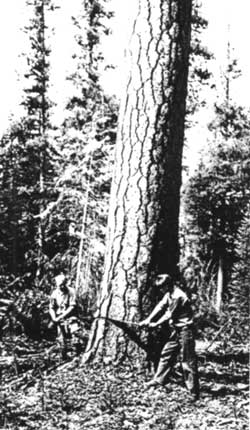Letters continued to come from Craighead to Keen in September and October 1931 in the interest of nailing down this outbreak that was so embarrassingly difficult to control. In a letter of September 21, Craig head tells Keen, [33]
My advice on the Crater would be that 100% treatment be given on all areas where the infestation is grouped and thus aim to thoroughly clean such areas but do nothing on those areas where infestation is scattered and obviously endemic, i.e., where no grouping occurs and where infested trees are not thrifty or do not contain vigorous broods. If such a plan is adopted and all areas are surveyed for the next few years, at least by topographic methods, it should be possible to keep down all epidemic infestation. This however may mean some little work each year for some years to come but I am afraid that is what we are coming to in all lodge pole forests where protection is necessary without utilization.
Craighead recognized, based on a concurrent similar outbreak in Yellowstone National Park, that the battle was a holding action at best. In October, Craighead acknowledged receipt of a report from Keen and Beal on a survey of the park and surrounding area. The report is missing from my files; evidently the number of infested trees was substantial, and there was concern for a newly infested area on Forest Service and private land in the Sun Mountain area. [34]
A report by Keen dated January 25, 1932, summarized control accomplishments in 1931 and made recommendations for 1932 work. [35] The report made some amazing statements considering all that had transpired. For instance Keen stated in his summary:
|
|
Ever since control work started on Crater Lake National Park, the treated areas have been menaced with neighboring infestation and the threat of beetle migration from heavily infested centers. In the early years the heavy centers were north of the Lake, but gradually these have been working around to the south and playing out. Control work during the last few years has had less migration of beetles to contend with. At no time, except possibly at the very beginning of this epidemic would it have been possible to wipe out all possible sources of infestation except at a tremendous and doubtfully justifiable expense.
The policy, which has been followed of repeatedly cleaning out the infestation in the recreational areas south of the Lake, and in the last few years of extending this work to take in all neighboring epidemic centers, is in my estimation the only feasible policy which would have been adopted. Far from considering the Crater work a failure, I believe it is the most successful which has ever been undertaken in the control of this beetle under the circumstances of poor isolations which this work has had to face.
Repeatedly and consistently the control work has brought about reductions averaging 75 percent, in spite of the threat of nearby infestation. A record which convinces me that local control is successful, provided sudden and concentrated migrations do not occur. Only in 1926 are we sure that such a migration occurred on the Crater when the beetles swept into the Munson plateau after it had been thoroughly treated. Of course, as soon as it becomes financially feasible to wipe out all sources of migration it should be done, and at the present time this comes nearer to being possible than in any previous year.


